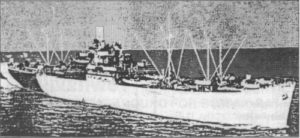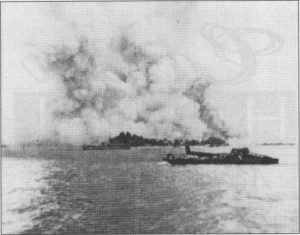- Author
- Thomson, Max
- Subjects
- History - WW2, Letter to the Editor
- Tags
-
- RAN Ships
- HMAS Hawkesbury I
- Publication
- June 1999 edition of the Naval Historical Review (all rights reserved)
Dear Editors,
Two quite enthralling packages came to me last week – one from Morton PA in America and the other from Anchorage, Alaska USA – all as a result of one of your NHS Monographs that had been bought in Sydney and taken back to America.
I felt you may be interested in the attached for Review… for it also is a tribute to the NHS and its production of those monographs… in this instance No. 11 titled: THE DAY IT RAINED METAL AT MANUS.
Hoping you may see merit in this for NAVAL HISTORICAL REVIEW because of its interest in itself… and as a tribute to the NHS and the splendid series of monographs.
Max Thomson (Vic Chapter, Member)

With 743 men killed, declared missing or wounded, the explosion of the American ammunition ship USS Mount Hood at Manus Fleet Base was one of the most horrendous disasters of the wartime Pacific.
It was of special significance too because, in those days, the Admiralty Islands were Australian Mandated Territory.
Under the title: “THE DAY IT RAINED METAL AT MANUS”, the Naval Historical Society of Australia produced monograph No. 11 (Max Thomson) which still sells at the Australian War Memorial bookshop in Canberra, at the National Maritime Museum bookshop at Darling Harbour and at N.H.S. headquarters, Sydney.
A visiting American recently took back to the USA a copy of that monograph documentation and, “out of the blue” some fascinating material from US sources has been forwarded.
In the NHS monograph, two on-duty signalmen on the bridge of the frigate HMAS Hawkesbury gave eye-witness accounts of the two actual explosions and the dreadful aftermath. Their ship was anchored in the vicinity and was badly rocked by the holocaust.
The monograph also detailed material researched from the US Archives office, including the finding of a board convened in the USA to examine evidence relating to the disaster but which was unable to pinpoint precisely the specific cause.
Archie Trader, who lives at Morton PA in the USA, was enthralled to read it all. For him, every day must now seem a bonus, for Archie was one of a small select group of USS Mount Hood crewmen who survived the disaster. The ship’s Communications Officer (Lt. L.A. Wallace) had taken 17 men ashore from USS Mount Hood to stretch their legs along the beach!
At 0855 on November 10, 1944 they saw an initial flash then two great explosions out in the harbour at Manus. Scrambling back into their boat, they headed for USS Mount Hood – only to be turned back because of the immense debris raining down from the sky as the aftermath of the explosion.

Some 3800 tons of ammunition had exploded. Flame and smoke shot up amidships to more than masthead height then, within a few seconds, the bulk of the ammunition destined for warships involved in the Philippine onslaughts was set off with a terrific explosion. Smoke mushroomed 7000 feet into the air and obscured the ship and surrounding vicinity – a radius of approximately 500 yards on all sides. When the smoke lifted from the surface of the water a few minutes later, only small pieces of debris were to be seen. USS Mount Hood and all personnel on board had disappeared.
The force of the explosion blasted a trough in the ocean floor more than 100 yards long, 50 feet wide and from 30 to 40 feet deep directly below the position of USS Mount Hood.
No fragments could be found on the ocean floor larger than bits of metal 16 feet by 10 feet.
Some fragments landed more than 2000 yards from the anchorage of USS Mount Hood. The concussion and flying debris caused casualties and damage to ships and small craft within that radius.




